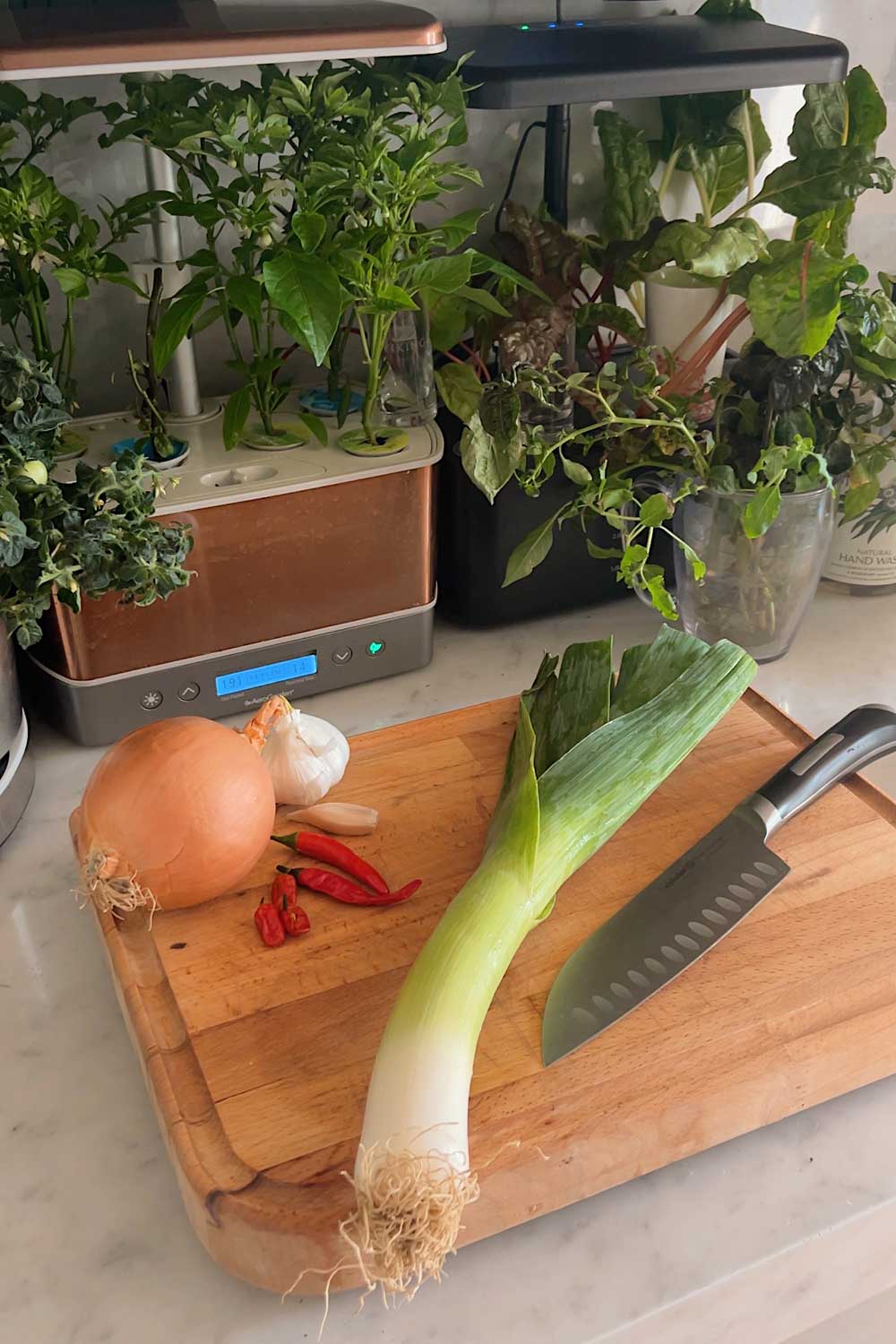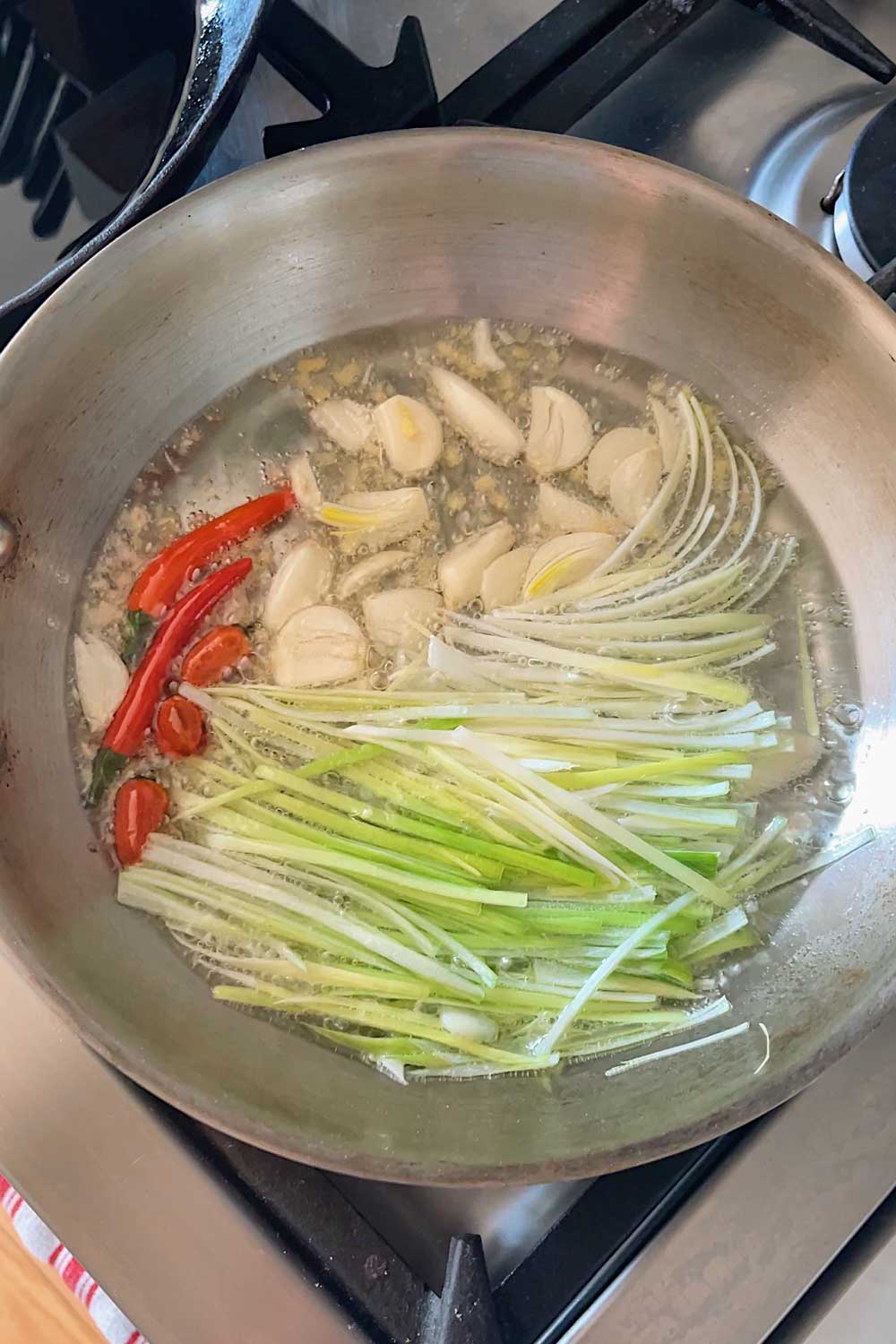Crunchy, spicy, garlicky – kkanpunggi is a popular Korean Chinese dish that’s so addicting to eat. Bite sized pieces of chicken are double fried and coated in a sweet, spicy glaze. Make this once and I guarantee you’ll want to make it again!

Korean Spicy Garlic Fried Chicken
The first time I tried kkanpunggi, I was hooked.
It’s a fried chicken dish, but made with bite sized pieces of boneless chicken and typically served over rice. The addicting part is the sauce – a sticky sweet glaze with a dash of heat and nice crunch, thanks to aromatics like peppers, onions and leeks.
Kkanpunggi isn’t really Chinese food and isn’t quite traditional Korean food. It’s more a fusion, found in Chinese restaurants in Korea!
I guess it’s kind of like a Korean version of kung pao chicken, but modified with Korean ingredients and to suit korean tastes. In Chinese, kkan means dry, pung means stir fry and gi means chicken.
Korean Chinese Fusion Food
There’s been a small community of Chinese people in Korea since the 1880s.
Most of them came from Shandong province in Northeastern China and settled in the Korean port city of Incheon. So a lot of Korean Chinese cuisine is influenced by northern and eastern Chinese food.
There are a couple really popular Chinese dishes that have been given a uniquely Korean twist. For your crunchy and sweet cravings, there’s tangsuyuk, sweet and sour pork, and kkanpunggi, spicy garlic fried chicken.
And for your noodle cravings, there’s jajangmyeon, black bean noodles and jjampong, spicy seafood noodle soup.
Kkanpunggi Recipe Video
@shershegrows some like it hot 🌶🌶🌶 #kkanpunggi spicy garlic fried chicken #koreanfood #aerogardenfarm #indoorgardening #aerogarden #apartmentgardening
Out of all the Korean Chinese dishes, kkanpunggi is my favorite!
It’s everything you want in an addicting dish: crunchy, sweet, slightly sticky and spicy!
The chicken is bite sized (easy to eat), boneless (no getting your hands dirty) and I always have seconds (and sometimes thirds!) I also prefer to make this at home rather than get takeout.
Fried food taste best when it’s freshly made.
Plus, when you make it yourself, you can choose the best protein. One of my pet peeves is ordering delivery and finding that all the meat is huge chunks of fat and fried batter, with very little actual pork or chicken.
Chicken Breast or Thigh
You can use either chicken breast or thigh for this recipe. Just cut it into bite sized chunks, about 1 to 2 inches.
Personally, I prefer boneless, skinless chicken thighs. Thighs are more juicy than breast and removing the skin helps the chicken pieces to crisp up better during the fry.
You can also substitute this with shrimp, if you prefer seafood!



Adjusting the Spice Level
I love spicy food and use both fresh hot peppers and dried chili peppers in this recipe.
If you use just dried chilis, the heat won’t be as intense.
For fresh chilis, you can use any kind of spicy pepper that you like. Jalapenos will be the mildest heat level, while cayenne, thai chilis and habernos will add more intense spice. You can also adjust the spice level by removing more of the seeds and pith from spicy peppers (that’s where most of the heat is contained).
In fact, I like spice so much I grow my own hot peppers in my apartment and plan to make my own dried spices and hot sauce! I like using my ornamental peppers in this dish. They’re small, hot but not too hot and add a lot of color.
But, if you don’t like heat – don’t worry.
This dish tastes just as good if you omit the chili peppers altogether and just use sweet bell peppers. I recommend using a yellow, orange or red bell pepper for color.
But adding even just a tad spiciness will bring out a lot of flavor.
Infusing Oil
This is a recipe that’s very simple, but has a couple steps.
The first is to make a chili garlic and leek infused oil. You could skip this, and just use a store-bought chili oil (like lao gan ma), but I really like making the infused oil fresh!
Garlic, ginger and leeks create a really aromatic, fresh flavor to the oil.
For a kick and a really beautiful red color to the oil, I add a heaping spoon of Korean red pepper spice, called gochugaru. You can also substitute with chili flakes.
Use Sweet Potato Starch

This recipe calls for breading the chicken in sweet potato starch and also adding potato starch to the sauce. If you don’t have it, you can substitute with equal parts flour and cornstarch.
But, I really recommend using sweet potato starch!
Sweet potato starch is special because it makes for extra crispy chicken that also stays crunchy for longer. It makes a noticeable difference in the final taste, both in the crispiness of the chicken and the glossy thickness of the sauce.
The scientific reason is because potato starch has a lower amylose content and larger granule size compared to other starches (especially cornstarch).
So when you deep fry with sweet potato starch, the lower amylose content allows water to evaporate more easily while the larger molecule size creates a more rigid, porous structure. Both of which translate to more crunch.
In sauces, sweet potato starch acts as a thickener to help bind the sauce together. It also creates a glossier shine and color compared to cornstarch (but can get a little gloopy, so we use just a little).
For a deeper dive, check out Serious Eat’s guide to potato starch.
Double Fry for Extra Crunch
You’ll also want to double fry the chicken! This gives it extra crunch and also a beautiful golden brown color.
For frying, always use a neutral oil with a high smoke point, like vegetable or canola oil, and a kitchen thermometer to test the temperature.
- First fry: 350°F
- Second fry: 375°F
The initial batch of frying is to cook the chicken.



Add each piece one by one and gently stir to prevent the chicken from clumping together.
Once all the chicken bites have been cooked, remove the pieces with a strainer and let them rest on a plate lined with paper towels. Keep the heat on and wait until all the little bubbles in the oil have evaporated.
Re-test the oil temperature and wait for the second fry to reach a temperature of 375°F.
Then, re-fry your chicken pieces. The second fry is much shorter, just two minutes or so. It creates an extra crispy texture and a deeper, richer color.
After frying, you can store the oil to reuse for later fries. Just strain out any bits of batter or food debris and keep it in a clean container.
Kkanpunggi Sauce

The best part about this dish is the sauce.
It’s a savory sticky garlic sauce that has the addicting Chinese-takeout style combo of sweet and sour. By cooking the sauce mixture, it brings out the garlic flavor and reduces the sauce to a nice thick glaze.
Try to time the second frying and the sauce reduction at the same time.
That way, you can immediately take out the chicken bites from their second fry and drop them into the kkanpunggi sauce so they get a nice, glossy coat of spicy garlic sauce.
I like to use honey for the sauce but you can also use white sugar or Korean rice syrup (which is more traditional).
Honey tends to caramelize quickly so just be sure to turn the heat down slightly so the sauce doesn’t dry out or thicken up too much.

Korean Spicy Garlic Fried Chicken (Kkanpunggi)
Crunchy, spicy, garlicky - kkanpunggi is a popular Korean Chinese dish that's so addicting to eat. Bite sized pieces of chicken are double fried and coated in a sweet, spicy glaze.
Ingredients
- ½ pound chicken, cut into bite sized pieces
- 1 tsp soy sauce
- ¼ tsp black pepper
- 1 egg white
- ½ cup potato starch
- Sesame oil, for garnish
- Sesame seeds, for garnish
Spicy Garlic & Leek Oil
- ¼ cup neutral oil
- ½ cup leeks, thinly shredded
- 1 tbsp Korean red pepper flakes
- 5 cloves of garlic
- ½ tsp ginger, minced
Vegetables
- 1-2 hot peppers
- 3-4 dried chili peppers
- 1 green onion, thinly sliced
- 1 small bell pepper, diced
- Half an onion, diced
Spicy Garlic Sauce
- 1 tbsp soy sauce
- 2 tbsp water
- 2 tbsp honey
- 1 tbsp mirin
- 1 tsp potato starch
Instructions
- Season the chicken pieces with soy sauce and pepper. Add one egg white and ½ cup of potato starch to the chicken and thoroughly mix by hand. Set aside.
- Make the spicy garlic sauce by combining soy sauce, water, honey, white vinegar and potato starch in a small bowl.
Create the Infused Oil
- Heat up a small pan with neutral cooking oil. Once the oil is hot, turn the heat down to low and add garlic, ginger, leeks and chili flakes.
- Cook slowly to infuse the oil with the aromatics, being careful not to let the garlic burn.
- Pour the infused oil into a bowl, straining out the garlic, leeks and chili flakes.
- Set the leeks aside for garnish and discard the others.
Fry the Chicken
- Add a neutral cooking oil to a small pot and heat up the oil to 350°F.
- Carefully fry each piece of chicken until it turns crunchy and light golden brown, about 5 minutes. Gently flip each piece and swirl to prevent any chicken bites from sticking together.
- Once fried, strain the chicken and place onto a wire tray to rest.
- Prepare to fry the chicken a second time.
- Heat up the oil until it reaches 375°F and all the bubbles have evaporated. Add the chicken back in. Fry until golden brown, just 2 to 3 minutes. Strain
Vegetable + Aromatics
- In a pan, stir fry the onion and bell pepper until golden brown. Add the green onion, hot peppers and small dried chilis as well as the spicy garlic leek oil until the peppers are lightly roasted.
- Turn down the heat and add the spicy garlic sauce. It should reduce to a thick, glossy glaze. Turn off the heat.
- Add in your double fried chicken and stir to coat each piece in the sticky spicy sauce.
- Turn off the heat and garnish with sesame oil and sesame seeds.
- Top with the previously fried leeks and garlic and serve over rice.
Notes
Adapted from Maangchi
Recommended Products
As an Amazon Associate and member of other affiliate programs, I earn from qualifying purchases.
Follow me on





